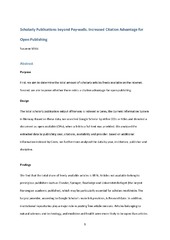Scholarly Publications beyond Pay-walls. Increased Citation Advantage for Open Publishing
Journal article
Submitted version

Åpne
Permanent lenke
https://hdl.handle.net/1956/16779Utgivelsesdato
2017Metadata
Vis full innførselSamlinger
Sammendrag
Purpose: First, we aim to determine the total amount of scholarly articles freely available on the internet. Second, we aim to prove whether there exists a citation advantage for open publishing. Design: The total scholarly publication output of Norway is indexed in Ceres, the Current Information System in Norway. Based on these data, we searched Google Scholar by either DOIs or titles and denoted a document as open available (OAv), when a link to a full-text was provided. We analysed the extracted data by publishing year, citations, availability and provider. Based on additional information indexed by Ceres, we furthermore analysed the data by year, institution, publisher and discipline. Findings: We find that the total share of freely available articles is 68 %. Articles not available belong to prestigious publishers such as Elsevier, Springer, Routledge and Universitetsforlaget (the largest Norwegian academic publisher), which may be particularly essential for scholars worldwide. The largest provider, according to Google Scholar’s main link provision, is ResearchGate. In addition, institutional repositories play a major role in posting free article versions. Articles belonging to natural sciences and technology, and medicine and health were more likely to be open than articles 2 belonging to the social sciences and humanities. Their respective OAv-shares are 72 %, 58 % and 55 %. We find a clear citation advantage for open publishing; on average, these documents received twice as many citations, indicating that open access is the future in publishing. Limitations: This study is limited to scholarly articles only. Books and book chapters, which are usual publication formats for the humanities and social sciences, are excluded. Results do therefore not adequately reflect the situation for these disciplines. Furthermore, this study is limited to documents freely available on the internet, independent of the “legal” status of the posted full-text. With the data at hand, we were not able to distinguish between gold, green, hybrid, purely pay-walled and illicitly posted documents. Value: Usually, articles indexed in Web of Science or SCOPUS are objects of investigation. However, these databases do not sufficiently cover the humanities and social sciences, and therefore cannot be representative of the total scholarly article output. This study captures the total article output of a country, independent on discipline and provides new insight into open publishing.